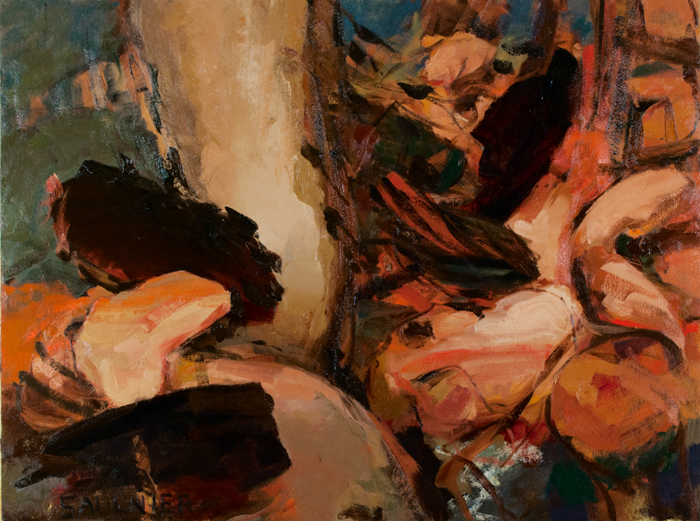Dana Saulnier

Untitled Study, 2014, oil on canvas, 42″ x 56″
I can say that my drive to make art is a desperate issue for me. If I was motivated narrowly by my desire to place myself in some kind of professional situation, where I was primarily concerned with the work’s status within a narrow set of theoretical discourses, then I am not sure that I could proceed with the faith and doubt necessary to the work. I want the work to make sense to people whether they are educated in art theory or not. Like good music I hope good art takes you in. It is hard work to make art and I want to think that it matters to people. That it enlarges our capacity for living.
—Dana Saulnier
In an interview a bit harder to penetrate than this lucid remark in the middle of it, Dana Saulnier offers a couple of tangentially related thoughts. I spotted his work in the recent exhibit at Manifest Gallery, so I delved deeper into the paintings already familiar to me from his show at First Street. In this brief observation, Saulnier resists the professionalization of art. It sounds as if he’s saying that he refuses to find his place in whatever happens to be going on theoretically or, as I would put it, conceptually, in the art world. He doesn’t need to belong. I like this, because he’s asserting his individuality, but also because theory comes second here. Starting from conceptual premises works against painting’s ability to convey an awareness more oceanic than conscious thought–so it’s ass backwards to make a painting to illustrate an idea or a theory of art. To look for significance in visual art can obscure what it’s actually doing. An industry of critical thought depends on the need to extract significance from creative work. As Tom Wolfe pointed out in The Painted Word, to make work that depends on criticism for elucidation or justification upends the relationship between creativity and critique: the critic rules the creator. Postmodernism depends on this. Painting begins to obey the need to be significant in such a way that it will attract critical approval. What gets put aside is attention to what a painting can do, in contrast to what, say, a novel does. Work that arises out of a theory of art, or any conscious purpose, reduces a painting to the role of “signifier” which has, at least, the virtue of keeping critics busy. It sounds as if maybe Saulnier wants to sidestep all of that and allow his work a more elusive impact—though his own critical thought about his work throughout the rest of the interview would seem to argue otherwise.
In this short reflective comment, though, he also says he wants his work to be available and effective, in some way, for people who know little or nothing about art in general—again suggesting that a painting’s work is unmediated, requiring neither commentary nor training. Looking is required; thinking optional and not advised. (Tolstoy’s theories of art toward the end of his life took a similar stance, repudiating much of the Western canon that most educated people would have considered sacrosanct—and quite a bit I would hate to lose, personally. But his intent was to remain true to the wisdom he earned after narrowly avoiding the impulse to kill himself over his inability to understand life intellectually, all of which he dramatized in Anna Karenina.) Granted, some of the most thrilling and powerful visual art has significance in the sense that it conveys much that can be clarified by criticism and commentary and training. It represents ideas, it has significance, the way language does. Yet, for me, the greatest painting has no significance whatsoever, but is instead a perceptual catalyst, a representation only in the sense that an aroma represents a meal. A scent doesn’t signify anything but its provenance—it’s an element of its life-sustaining origin and it brings you toward that origin in the way a painting by Braque could be said to embody the world it invites the viewer to inhabit. How it does this is utterly mysterious, and that isn’t a reality that offers much mileage to critical conversations about it.
Comments are currently closed.